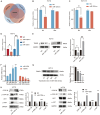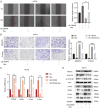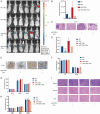Resveratrol restrains colorectal cancer metastasis by regulating miR-125b-5p/TRAF6 signaling axis
- PMID: 38859844
- PMCID: PMC11162648
- DOI: 10.62347/ZBVG9125
Resveratrol restrains colorectal cancer metastasis by regulating miR-125b-5p/TRAF6 signaling axis
Abstract
Colorectal cancer is one of the most common malignancies with a high incidence, metastatic tendency and low 5-year survival rate. Resveratrol, a polyphenolic compound has been shown to inhibit colorectal cancer metastasis in recent studies. Its underlying molecular mechanism remains to be elucidated. Our findings demonstrated that miR-125b-5p, acting as a tumor suppressor, was conspicuously down-regulated in both colorectal cancer tissues and cell lines. The expression of miR-125b-5p negatively correlated with the expression of its direct target TNF receptor associated factor 6 (TRAF6). Both miR-125b-5p overexpression and TRAF6 knockdown inhibited metastasis of colorectal cancer cells. In addition, we uncovered that resveratrol up-regulated miR-125b-5p by increasing its stability and suppressed TRAF6-induced signal pathway in a dose/time-dependent manner. Resveratrol could significantly curtail the migration and invasion of colorectal cancer cells, which was counteracted by miR-125b-5p knockdown or TRAF6 overexpression. These results indicated that resveratrol could restrain colorectal cancer metastasis by promoting miR-125b-5p/TRAF6 signaling axis. Furthermore, lung metastasis models of colorectal cancer were constructed by tail vein injection. Down-regulation of miR-125b-5p could facilitate colorectal cancer metastasis in vivo, which could be impeded by resveratrol. In conclusion, our findings delineated the miR-125b-5p/TRAF6 signaling axis as a novel molecular mechanism underlying the metastatic process in colorectal cancer, as well as a prospective therapeutic target. Resveratrol disrupts colorectal cancer metastasis by activating miR-125b-5p/TRAF6 signal pathway and might improve the clinical outcome of colorectal cancer patients with low expression of miR-125b-5p.
Keywords: Resveratrol; TRAF6; colorectal cancer; metastasis; miR-125b-5p.
AJCR Copyright © 2024.
Conflict of interest statement
None.
Figures








Similar articles
-
Mesenchymal stem cell exosomes inhibit nucleus pulposus cell apoptosis via the miR-125b-5p/TRAF6/NF-κB pathway axis.Acta Biochim Biophys Sin (Shanghai). 2023 Dec 25;55(12):1938-1949. doi: 10.3724/abbs.2023241. Acta Biochim Biophys Sin (Shanghai). 2023. PMID: 37964606 Free PMC article.
-
LncRNA AK089514/miR-125b-5p/TRAF6 axis mediates macrophage polarization in allergic asthma.BMC Pulm Med. 2023 Jan 30;23(1):45. doi: 10.1186/s12890-023-02339-1. BMC Pulm Med. 2023. PMID: 36717790 Free PMC article.
-
Resveratrol protects BV2 mouse microglial cells against LPS-induced inflammatory injury by altering the miR-146a-5p/TRAF6/NF-κB axis.Immunopharmacol Immunotoxicol. 2019 Oct;41(5):549-557. doi: 10.1080/08923973.2019.1666406. Epub 2019 Sep 18. Immunopharmacol Immunotoxicol. 2019. PMID: 31530042
-
LncRNA MAFG-AS1 regulates miR-125b-5p/SphK1 axis to promote the proliferation, migration, and invasion of bladder cancer cells.Hum Cell. 2021 Mar;34(2):588-597. doi: 10.1007/s13577-020-00470-3. Epub 2021 Jan 5. Hum Cell. 2021. PMID: 33400245 Free PMC article.
-
MIR4435-2HG, miR-125b-5p, and Sema4D axis affects the aggressiveness of colorectal cancer cells.Folia Histochem Cytobiol. 2022;60(2):191-202. doi: 10.5603/FHC.a2022.0018. Epub 2022 Jun 22. Folia Histochem Cytobiol. 2022. PMID: 35730423
Cited by
-
Structurally diverse bufadienolides from the skins of Bufo bufo gargarizans and their cytotoxicity.Sci Rep. 2024 Nov 9;14(1):27344. doi: 10.1038/s41598-024-79194-5. Sci Rep. 2024. PMID: 39521925 Free PMC article.
-
The interplay of exercise and green tea: a new road in cancer therapy.Cancer Cell Int. 2025 Jan 7;25(1):6. doi: 10.1186/s12935-024-03632-7. Cancer Cell Int. 2025. PMID: 39773739 Free PMC article. Review.
References
-
- Siegel RL, Wagle NS, Cercek A, Smith RA, Jemal A. Colorectal cancer statistics, 2023. CA Cancer J Clin. 2023;73:233–254. - PubMed
-
- Siegel RL, Miller KD, Wagle NS, Jemal A. Cancer statistics, 2023. CA Cancer J Clin. 2023;73:17–48. - PubMed
-
- Ciardiello F, Ciardiello D, Martini G, Napolitano S, Tabernero J, Cervantes A. Clinical management of metastatic colorectal cancer in the era of precision medicine. CA Cancer J Clin. 2022;72:372–401. - PubMed
-
- Biller LH, Schrag D. Diagnosis and treatment of metastatic colorectal cancer: a review. JAMA. 2021;325:669–685. - PubMed
LinkOut - more resources
Full Text Sources
